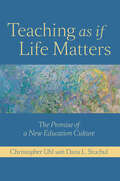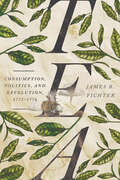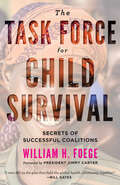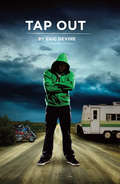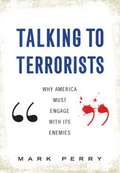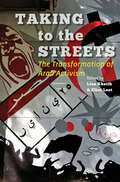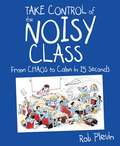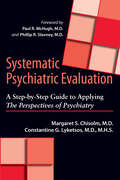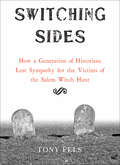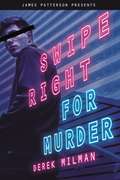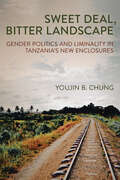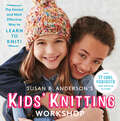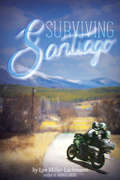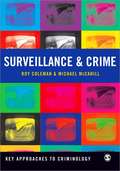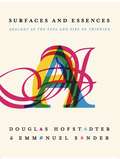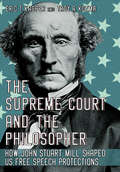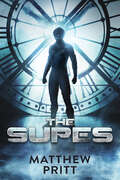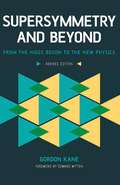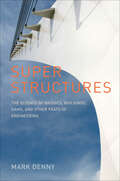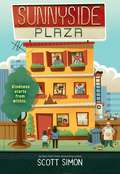- Table View
- List View
Teaching as if Life Matters: The Promise of a New Education Culture
by Christopher UhlWhat would it be like to teach as if life matters? To move beyond the typical regimen of classroom exercises, homework, and standardized tests and to guide students through life’s most important lessons? Dissatisfied with traditional educational models, Christopher Uhl and Dana L. Stuchul asked themselves these questions. What they discovered will open the eyes of today’s educators to a whole new way of teaching.The authors promote an approach that fosters self-knowledge, creativity, curiosity, and an appreciation for our planet. Central to their philosophy is the question of what we humans need in order to live meaningful lives. The answer: healthy relationships with ourselves, each other, and the world. Teaching as if Life Matters is an open letter to teachers offering guidance and encouragement for nurturing students in ways that make teaching and learning meaningful. In short, it is a passionate plea for transformative teaching. Informed by the alternative educational philosophies of John Dewey, Maria Montessori, Rudolf Steiner, and Ivan Illich, this book invites teachers and students to participate in a new culture of education.This fascinating and urgently needed book will inspire today’s educators to inspire their students.
Tea: Consumption, Politics, and Revolution, 1773–1776
by James R. FichterIn Tea, James R. Fichter reveals that despite the so-called Boston Tea Party in 1773, two large shipments of tea from the East India Company survived and were ultimately drunk in North America. Their survival shaped the politics of the years ahead, impeded efforts to reimburse the company for the tea lost in Boston Harbor, and hinted at the enduring potency of consumerism in revolutionary politics.Tea protests were widespread in 1774, but so were tea advertisements and tea sales, Fichter argues. The protests were noisy and sometimes misleading performances, not clear signs that tea consumption was unpopular. Revolutionaries vilified tea in their propaganda and prohibited the importation and consumption of tea and British goods. Yet merchant ledgers reveal these goods were still widely sold and consumed in 1775. Colonists supported Patriots more than they abided by non-consumption. When Congress ended its prohibition against tea in 1776, it reasoned that the ban was too widely violated to enforce. War was a more effective means than boycott for resisting Parliament, after all, and as rebel arms advanced, Patriots seized tea and other goods Britons left behind. By 1776, protesters sought tea and, objecting to its high price, redistributed rather than destroyed it. Yet as Fichter demonstrates in Tea, by then the commodity was not a symbol of the British state, but of American consumerism.
The Task Force for Child Survival: Secrets of Successful Coalitions
by William W. FoegeDr. Bill Foege, one of the best-known names in global health, brings readers to the table during the creation of one of the world;€™s most famous and successful global health efforts;¢;‚¬;€?the Task Force for Child Survival.In 1984, the US immunization program was so successful that many childhood diseases were at record lows;¢;‚¬;€?yet 40,000 children a day were dying around the world from preventable diseases. That year, Dr. Foege, former director of the Centers for Disease Control and Prevention, came together with Jonas Salk, Robert McNamara, and representatives from UNICEF, the World Health Organization, the World Bank, the United Nations Development Programme, and the Rockefeller Foundation to see how some of the lessons learned in America could be applied to global programs. The assembled participants recommended the formation of a small task force to help UN agencies improve immunization coverage. They dubbed it the Task Force for Child Survival and installed Foege as its first leader.In this book, Dr. Foege describes the task force from its conception through its landmark success. Over its first six years, as more resources were allocated to the task force, immunization coverage climbed from approximately 15 percent of the world;€™s children for some vaccines to 80 percent of the world;€™s children for at least one vaccine. UNICEF head Jim Grant called it the greatest peacetime endeavor the world had ever seen. How did this small, independent, low-profile group leverage change in the largest of global health agencies? Foege dissects each element for clues as to why the task force was able to accomplish so much so quickly, ultimately concluding that coalition-building played a major role and explaining how to strengthen coalitions by scrupulously avoiding the turf guarding and credit seeking that are so common to international endeavors.Inspiring and accessible, this brief book combines the distilled advice of one of global health's major leaders with the history of an iconic public health program.
The Task Force for Child Survival: Secrets of Successful Coalitions
by William W. FoegeDr. Bill Foege, one of the best-known names in global health, brings readers to the table during the creation of one of the world;€™s most famous and successful global health efforts;¢;‚¬;€?the Task Force for Child Survival.In 1984, the US immunization program was so successful that many childhood diseases were at record lows;¢;‚¬;€?yet 40,000 children a day were dying around the world from preventable diseases. That year, Dr. Foege, former director of the Centers for Disease Control and Prevention, came together with Jonas Salk, Robert McNamara, and representatives from UNICEF, the World Health Organization, the World Bank, the United Nations Development Programme, and the Rockefeller Foundation to see how some of the lessons learned in America could be applied to global programs. The assembled participants recommended the formation of a small task force to help UN agencies improve immunization coverage. They dubbed it the Task Force for Child Survival and installed Foege as its first leader.In this book, Dr. Foege describes the task force from its conception through its landmark success. Over its first six years, as more resources were allocated to the task force, immunization coverage climbed from approximately 15 percent of the world;€™s children for some vaccines to 80 percent of the world;€™s children for at least one vaccine. UNICEF head Jim Grant called it the greatest peacetime endeavor the world had ever seen. How did this small, independent, low-profile group leverage change in the largest of global health agencies? Foege dissects each element for clues as to why the task force was able to accomplish so much so quickly, ultimately concluding that coalition-building played a major role and explaining how to strengthen coalitions by scrupulously avoiding the turf guarding and credit seeking that are so common to international endeavors.Inspiring and accessible, this brief book combines the distilled advice of one of global health's major leaders with the history of an iconic public health program.
Tap Out
by Eric DevineSeventeen-year-old Tony Antioch lives in Pleasant Meadows, a trailer park where questions aren't asked since everyone already knows the answers from their own experience. He dreams of rescuing his mother from her constant stream of abusive boyfriends but in reality can barely duck the punches that are aimed at himself.When Tony is coerced into joining his friend Rob's Mixed Martial Arts class, he is surprised to find that he has a talent that he actually wants to develop. But with a meth-dealing biker gang that is hungry for recruits and a vicious cycle of poverty and violence that precedes him, Tony is going to need a lot more than blood and guts to find a way out.Gritty, powerful, and unapologetic, Tap Out explores what it takes to stay true to oneself and the consequences of the choices made along the way in order to do so.
Talking to Terrorists: Why America Must Engage with its Enemies
by Mark PerryIt has long been an article of faith that the United States does not "talk to terrorists”-that to engage in dialogue with groups such as Hamas, Hezbollah, and the Muslim Brotherhood would be tacitly to acknowledge their status as legitimate political actors. Not so, argues Middle East expert Mark Perry. In the absence of dialogue, we have lumped these groups together with Al Qaeda as part of a monolithic enemy defined by a visceral hatred of American values. In reality, while they hold deep grievances about specific US policies, they are ultimately far more defined by their opposition to the deliberately anti-political Salafist ideology of Al Qaeda.Drawing on extensive interviews with Washington insiders, Perry describes fruitful covert meetings between members of the US armed forces and leaders of the Iraqi insurgency to demonstrate that talking to terrorists may be best way to end terrorism-controversial wisdom we ignore at our peril.
Taking to the Streets: The Transformation of Arab Activism
by Lina Khatib Ellen LustTaking to the Streets critically examines the conventional wisdom that the 2011 Arab Spring uprisings happened spontaneously and were directed by tech-savvy young revolutionaries. Pairing first-hand observations from activists with the critical perspectives of scholars, the book illuminates the concept of activism as an ongoing process, rather than a sudden burst of defiance. The contributors examine case studies from uprisings in Tunisia, Egypt, Libya, Yemen, Syria, Bahrain, Morocco, Jordan, Kuwait, and Saudi Arabia, evaluating the various manifestations of political activism within the context of each country's distinct sociopolitical landscape. The chapters include a country-specific timeline of the first year following the uprisings and conclude with lessons learned. First-hand observations include those of Libyan activist Rihab Elhaj, who reflects on how the revolution gave birth to Libyan civil society, as well as Syrian writer and human rights activist Khawla Dunia, who discusses how Syrians have tried to remain steadfast in their commitment to nonviolent resistance.A foreword by Prince Hicham Ben Abdallah El Alaoui�third in succession to the Moroccan throne and consulting professor at Stanford University's Center on Democracy, Development, and the Rule of Law (CDDRL)�provides a historical overview of activism in the Middle East and North Africa. A postscript from CDDRL director Larry Diamond distinguishes the study of activism from that of democratization.Taking to the Streets will be used in courses on Middle East politics and will be relevant to scholars and the general public interested in democratization, political change, and activism.
Take Control Of The Noisy Class: From Chaos To Calm In 15 Seconds (PDF)
by Rob PlevinDo you struggle to get students to listen in your lessons? Do you find students dragging their heels to your lessons only to battle with you from bell to bell? Are you fed up with students who talk over you and ignore your instructions? Are you tired, drained and worn out because of low level disruption, disobedience and defiance? Do you long for a workable, practical system to help you take control and enjoy stress--free teaching? If you answered 'yes' to any of those questions you'll love the highly effective, proven strategies in Take Control of the Noisy Class! Teacher--trainer Rob Plevin explains a clear, step--by--step plan for successfully managing the most challenging individuals and groups in today's toughest classrooms. Written in a friendly and accessible style, and packed with powerful, fast--acting techniques -- including a novel tactic to get any class quiet in 15 seconds or less -- this book helps teachers transform their ability to connect and succeed with hard--to--reach, reluctant learners. Even if you have never had 'the class from hell', you'll find hundreds of practical, useable ideas and interventions to meet students' needs and create a thoroughly enjoyable classroom climate for all concerned. Take Control of the Noisy Class! provides teachers with a proven system for dealing with disruptive, inappropriate behaviour in the classroom, enabling them to create calm, positive learning environments and trusting bonds with hard--to--reach students. Discover: effective behaviour management strategies, the power of routines, instructions and consequences, the importance of relationships, tips and tricks for tackling misbehaviour, proven techniques for getting a rowdy class's attention, strategies for maintaining lesson flow and a positive learning environment and effective classroom management strategies which curb misbehaviour and prevent it reaching the stage of involving the senior leadership team and school behaviour policy. Super--effective classroom management strategies for today's toughest classrooms. Relevant to teachers of all subjects and age groups - across primary and secondary schools. Ideal for individual teachers and leaders or as the basis of whole--school.
Systematic Psychiatric Evaluation: A Step-by-Step Guide to Applying The Perspectives of Psychiatry
by Margaret S. Chisolm Constantine G. LyketsosThe Perspectives approach to psychiatry focuses on four aspects of psychiatric practice and research: disease, dimensional, behavior, and lifestory. In Systematic Psychiatric Evaluation, Drs. Margaret S. Chisolm and Constantine G. Lyketsos underscore the benefits of this approach, showing how it improves clinicians' abilities to evaluate, diagnose, and treat patients.Drs. Chisolm and Lyketsos use increasingly complex case histories to help the mental health provider evaluate patients demonstrating symptoms of bipolar disorder, psychosis, suicidal ideation, depression, eating disorders, and cutting, among other conditions. The book also includes an exercise that simulates the Perspectives approach side by side with traditional methods, revealing the advantages of a method that engages not one but four points of view. Featuring a foreword by Drs. Paul R. McHugh and Phillip R. Slavney, the originators of the Perspectives approach, this innovative book will be used in psychiatric training programs as well as by practicing mental health clinicians.
Systematic Psychiatric Evaluation: A Step-by-Step Guide to Applying <I>The Perspectives of Psychiatry</I>
by Margaret S. Chisolm Constantine G. LyketsosThe Perspectives approach to psychiatry focuses on four aspects of psychiatric practice and research: disease, dimensional, behavior, and lifestory. In Systematic Psychiatric Evaluation, Drs. Margaret S. Chisolm and Constantine G. Lyketsos underscore the benefits of this approach, showing how it improves clinicians' abilities to evaluate, diagnose, and treat patients.Drs. Chisolm and Lyketsos use increasingly complex case histories to help the mental health provider evaluate patients demonstrating symptoms of bipolar disorder, psychosis, suicidal ideation, depression, eating disorders, and cutting, among other conditions. The book also includes an exercise that simulates the Perspectives approach side by side with traditional methods, revealing the advantages of a method that engages not one but four points of view. Featuring a foreword by Drs. Paul R. McHugh and Phillip R. Slavney, the originators of the Perspectives approach, this innovative book will be used in psychiatric training programs as well as by practicing mental health clinicians.
Switching Sides: How a Generation of Historians Lost Sympathy for the Victims of the Salem Witch Hunt
by Tony FelsFor most historians living through the fascist and communist tyrannies that culminated in World War II and the Cold War, the Salem witch trials signified the threat to truth and individual integrity posed by mass ideological movements. Work on the trials produced in this era, including Arthur Miller;€™s The Crucible and Marion L. Starkey;€™s The Devil in Massachusetts: A Modern Enquiry into the Salem Witch Trials, left little doubt that most intellectuals;€™ sympathies lay with the twenty innocent victims who stood up to Puritan intolerance by choosing to go to their deaths rather than confess to crimes they had never committed.In Switching Sides, Tony Fels traces a remarkable shift in scholarly interpretations of the Salem witch hunt from the post;€“World War II era up through the present. Fels explains that for a new generation of historians influenced by the radicalism of the New Left in the 1960s and early 1970s, the Salem panic acquired a startlingly different meaning. Determined to champion the common people of colonial New England, dismissive toward liberal values, and no longer instinctively wary of utopian belief systems, the leading works on the subject to emerge from 1969 through the early 2000s highlighted economic changes, social tensions, racial conflicts, and political developments that served to unsettle the accusers in the witchcraft proceedings. These interpretations, still dominant in the academic world, encourage readers to sympathize with the perpetrators of the witch hunt, while at the same time showing indifference or even hostility toward the accused.Switching Sides is meticulously documented, but its comparatively short text aims broadly at an educated American public, for whom the Salem witch hunt has long occupied an iconic place in the nation;€™s conscience. Readers will come away from the book with a sound knowledge of what is currently known about the Salem witch hunt;¢;‚¬;€?and pondering the relationship between works of history and the ideological influences on the historians who write them.
Swipe Right for Murder
by Derek MilmanAn epic case of mistaken identity puts a teen looking for a hookup on the run from both the FBI and a murderous cult in this compulsively readable thriller.Finding himself alone in a posh New York City hotel room for the night, Aidan does what any red-blooded seventeen-year-old would do—tries to hook up with someone new. But that lapse in judgement leads him to a room with a dead guy and a mysterious flash drive . . . two things that spark an epic case of mistaken identity that puts Aidan on the run—from the authorities, his friends, his family, the people who are out to kill him—and especially from his own troubled past.Inspired by a Hitchcock classic, this whirlwind mistaken-identity caper has razor-sharp humor, devastating emotional stakes, and a thrilling storyline with an explosive conclusion to make this the most compelling YA novel of the year. Entertainment Weekly's Best YA Books of the SummerSeventeen Magazine's Best YA Books of the Year Goodreads Most Anticipated YA Books of the YearBuzzfeed's Best YA Summer ReadsMost Anticipated Queer Books of 2019 (Hypable)Barnes & Noble's Most Anticipated LGBTQAP YAs of the year11 New YA Books to Get Excited About (Pure Wow)29 New LGBTQ+ YA Books To Add To Your Reading List (Pride.com)
Sweethearts (Little Brown Novels)
by Sara ZarrAs children, Jennifer Harris and Cameron Quick were both social outcasts. They were also one another's only friend. So when Cameron disappears without warning, Jennifer thinks she's lost the only person who will ever understand her. Now in high school, Jennifer has been transformed. Known as Jenna, she's popular, happy, and dating, everything "Jennifer" couldn't be -- but she still can't shake the memory of her long-lost friend. When Cameron suddenly reappears, they are both confronted with memories of their shared past and the drastically different paths their lives have taken.From National Book Award finalist Sara Zarr, Sweethearts is a story about the power of memory, the bond of friendship, and the quiet resilience of our childhood hearts.
Sweet Deal, Bitter Landscape: Gender Politics and Liminality in Tanzania's New Enclosures (Cornell Series on Land: New Perspectives on Territory, Development, and Environment)
by Youjin B. ChungSweet Deal, Bitter Landscape brings us to the mid-2000s, when the Tanzanian government struck a deal with a foreign investor to convert more than 20,000 hectares of long-settled coastal land to establish a sugarcane plantation. Ten years on, the deal was abruptly abandoned. Popularly deemed a case of hubristic global development, critics classified this project another in a line of failed modern resource grabs. Youjin B. Chung argues such tidy accounts conceal myriad and profound implications: not only how gender, history, and culture shaped the project's trajectory, but also how, even in its stalled state, the deal upended social life on the land by setting in motion incomplete processes of development and dispossession. With rich ethnographic detail and visual storytelling, Sweet Deal, Bitter Landscape traces the lived experiences of diverse rural women and men as they struggled for survival under a seemingly endless condition of liminality. In so doing, she raises critical questions about the directions and stakes of postcolonial development and nation-building in Tanzania, and the shifting meanings of identity and belonging for those on the margins of capitalist agrarian transformation.
Sustainability, Innovation, and Entrepreneurship
by Andrea LarsonThis book is suited for the Entrepreneurship or Innovation course with an emphasis on Sustainability or for a course devoted entirely to Sustainability. The deep roots of sustainability thinking are now evident in widespread and increasingly visible activities worldwide, this text will help you and your students explore that necessity, its implications and its progression.
Susan B. Anderson's Kids' Knitting Workshop: The Easiest and Most Effective Way to Learn to Knit!
by Susan B. AndersonBeloved knitting instructor Susan B. Anderson presents her first book targeted at a young audience. This accessible introduction to knitting in the round includes easy-to-follow illustrated tutorials on techniques from casting on and binding off to joining colors to make stripes, and 17 progressively challenging knitting projects—beginning with simple infinity scarves and hats and building to supersweet toys and decor. Step-by-step text and photographs that kids can read and follow on their own mean they will be knitting independently in no time! Also included is a chapter on stocking your toolbox and sourcing yarn; plus advice on starting a knitting group, connecting with local knitting communities, charity knitting, and more.
Surviving Santiago
by Lyn Miller-LachmannReturning to her homeland of Santiago, Chile, is the last thing that Tina Aguilar wants to do during the summer of her sixteenth birthday. It has taken eight years for her to feel comfort and security in America with her mother and her new husband. And it has been eight years since she has last seen her father.Despite insisting on the visit, Tina's father spends all his time focused on politics and alcohol rather than connecting with Tina, making his betrayal from the past continue into the present. Tina attracts the attention of a mysterious stranger, but the hairpin turns he takes her on may push her over the edge of truth and discovery.The tense, final months of the Pinochet regime in 1989 provide the backdrop for author Lyn Miller-Lachmann's suspenseful tale of the survival and redemption of the Aguilar family, first introduced in the critically acclaimed Gringolandia.CCSS-aligned curriculum guidecan be found online at http://www.rpcurriculumguides.com/curriculum_guides.html
Survey of Economics Version 1.0
by Libby Rittenberg Timothy TregarthenThis Survey of Economics textbook is intended for the one-semester introductory economics course. Building on the pedagogy developed in their successful two-semester Principles of Economics textbook, Libby and Tregarthen cover topics that will give students the tools to understand the economics way of thinking.
Surveillance and Crime (PDF)
by Roy Coleman Mike MccahillSurveillance has a long-standing relationship with crime and its identification, prevention, detection and punishment. With information on each citizen spanning up to 700 databases, and over 4 million CCTV cameras in the United Kingdom alone, this book explores how new technologies have given rise to new forms of monitoring and control. 9781847873521 9781446245309 9781849204446 9781280347016 9781446251379
Surfaces and Essences: Analogy as the Fuel and Fire of Thinking
by Douglas Hofstadter Emmanuel SanderIs there one central mechanism upon which all human thinking rests? Cognitive scientists Douglas Hofstadter and Emmanuel Sander argue that there is. At this core is our incessant proclivity to take what we perceive, to abstract it, and to find resemblances to prior experiences—in other words, our ability to make analogies.In The Essence of Thought, Hofstadter and Sander show how analogy-making pervades our thought at all levels—indeed, that we make analogies not once a day or once an hour, but many times per second. Thus, analogy is the mechanism that, silently and hidden, chooses our words and phrases for us when we speak, frames how we understand the most banal everyday situation, guides us in unfamiliar situations, and gives rise to great acts of imagination.We categorize because of analogies that range from simple to subtle, and thus our categories, throughout our lives, expand and grow ever more fluid. Through examples galore and lively prose peppered, needless to say, with analogies large and small, Hofstadter and Sander offer us a new way of thinking about thinking.
The Supreme Court and the Philosopher: How John Stuart Mill Shaped US Free Speech Protections
by Eric T. Kasper Troy A. KozmaThe Supreme Court and the Philosopher illustrates how the modern US Supreme Court has increasingly adopted a view of the constitutional right to the freedom of expression that is classically liberal in nature, reflecting John Stuart Mill's reasoning in On Liberty. A landmark treatise outlining the merits of limiting governmental and social power over the individual, On Liberty advocates for a maximum protection of human freedom. Proceeding case by case and covering a wide array of issues, such as campaign finance, offensive speech, symbolic speech, commercial speech, online expression, and false statements, Eric T. Kasper and Troy A. Kozma show how the Supreme Court justices have struck down numerous laws for infringing on the freedom of expression.Kasper and Kozma demonstrate how the adoption of Mill's version of free speech began with Justice Oliver Wendell Holmes Jr. more than a century ago and expanded over time to become the prevailing position of the Court today. The authors argue that this embrace of Mill's rationale has led to an unmistakable reorientation in the Court's understanding of free expression jurisprudence.The Supreme Court and the Philosopher is the first book to comprehensively explore how the political philosophy of Mill has influenced the highest court in the land. In targeting the underlying philosophical reasons that explain why the modern Supreme Court renders its First Amendment decisions, this book is particularly timely, as the issues of censorship and freedom of expression are debated in the public square today.
The Supes
by Matthew PrittA group of failed teenage superheroes-in-training must unite not only to prove themselves worthy of the Super title but also to protect their school and loved ones. Readers will be gripped by this book chock-full of quick action and laughs.
Supersymmetry and Beyond: From the Higgs Boson to the New Physics
by Gordon KaneThe epic story of the quest to uncover a fully unified theory of physics, revised to reflect the possible discovery of the Higgs Boson.
Super Structures: The Science of Bridges, Buildings, Dams, and Other Feats of Engineering
by Mark DennyEver wonder how a graceful and slender bridge can support enormous loads over truly astonishing spans? Why domes and free-standing arches survive earthquakes that flatten the rest of a city?Physicist Mark Denny looks at the large structures around us—tall buildings, long bridges, and big dams—and explains how they were designed and built and why they sometimes collapse, topple, or burst. Denny uses clear, accessible language to explain the physics behind such iconic structures as the Parthenon, the Eiffel Tower, the Forth Rail Bridge in Edinburgh, and Hoover Dam. His friendly approach allows readers to appreciate the core principles that keep these engineering marvels upright without having to master complex mathematical equations. Employing history, humor, and simple physics to consider such topics as when to use screws or nails, what trusses are, why iron beams are often I-shaped, and why medieval cathedrals have buttresses, Denny succeeds once again in making physics fun.
Sunnyside Plaza
by Scott Simonp.p1 {margin: 0.0px 0.0px 0.0px 0.0px; font: 13.0px Times} p.p2 {margin: 0.0px 0.0px 0.0px 0.0px; font: 13.0px Times; min-height: 16.0px} Wonder meets Three Times Lucky in a story of empowerment as a young woman decides to help solve the mystery of multiple suspicious deaths in her group home. Sally Miyake can't read, but she learns lots of things. Like bricks are made of clay and Vitamin D comes from the sun. Sally is happy working in the kitchen at Sunnyside Plaza, the community center she lives in with other adults with developmental disabilities. For Sally and her friends, Sunnyside is the only home they've ever known. Everything changes the day a resident unexpectedly dies. After a series of tragic events, detectives Esther Rivas and Lon Bridges begin asking questions. Are the incidents accidents? Or is something more disturbing happening? The suspicious deaths spur the residents into taking the investigation into their own hands. But are people willing to listen? Sunnyside Plaza is a human story of empowerment, empathy, hope, and generosity that shines a light on this very special world.
